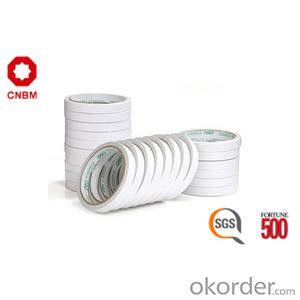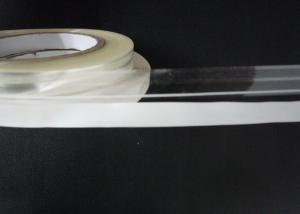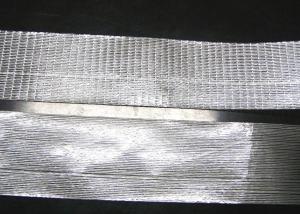Scotch Packaging Tape - Double Sided Tissue Tape for Bonding & Fixing Best Quality
- Loading Port:
- Shanghai
- Payment Terms:
- TT OR LC
- Min Order Qty:
- 10000 m²
- Supply Capability:
- 20000000 m²/month
OKorder Service Pledge
OKorder Financial Service
You Might Also Like
Specifications
·World Top 500 Enterprises
·Resistance to cold, heat and aging
·Best quality and competitive price
·SGS&ISO9001
Description
The Double Sided Tissue Tape is of tissue as the carrier, coating with hot melt adhesive, water based acrylic, solvent based acrylic. It is excellent in flame retardant, high temperature stability, and anti-aging. It provides well insulation to various products.
The thickness of the tape can be customized.
General purpose of Double Sided Tissue Tape: widely used for bonding, fixing for leather, foam, sponge, garment, shoe, luggage, plastic, paper splicing and stationery.
Typical Physical Reports of Double Sided Tissue Tape

Packaging Detail
The thickness of the tape can be customized.
Cut Roll: As per customer’s requirements
Log Roll: Length 1000mm; width: 1050mm, 1260mm, 1040mm..


FAQ of Double Sided Tissue Tape
Q1. How about your company?
CNBM International Corporation (CNBM International) is a state-owned company and we have sound business relations with clients from over 120 countries. Currently, we have wholly-owned overseas subsidiaries and branches in 5 countries with a view to realize localization, which also represents an essential progress in our globalization target. We have over twenty years experiences.
Q2. What kind of service we can provide for you?
Sample of Double Sided Tissue Tape is available.
Your inquiry will be replied within 12 hours.
24 hours service for you
Well-trained & experienced sales representative are ready to answer you.
Q3. How long can you receive the product?
Within 7-15 working days after receiving your deposit
Welcome to contact us and visit the factory!
- Q: Can packaging tape be used for sealing electronic devices?
- No, packaging tape is not suitable for sealing electronic devices as it lacks the necessary insulation and protection against moisture and static electricity that electronic devices require. Specialized tapes or adhesives designed for electronics should be used for proper sealing.
- Q: How do I remove packaging tape without damaging the surface?
- To remove packaging tape without damaging the surface, you can try using a hairdryer to gently heat the tape, which will make it easier to peel off. Alternatively, you can use a small amount of rubbing alcohol or vinegar to dissolve the adhesive before carefully peeling it off. It's important to be patient and take your time to prevent any potential damage to the surface.
- Q: Does packaging tape come in different odor-free options?
- Indeed, there are various odorless alternatives available for packaging tape. Numerous manufacturers provide packaging tape explicitly crafted to be free from any scent, rendering it appropriate for utilization in delicate settings or for individuals susceptible to allergies or sensitivities towards specific aromas. Typically, these odorless choices are manufactured using materials that do not release any intense odors or fragrances, guaranteeing a neutral and enjoyable packaging experience. Before purchasing packaging tape, it is advisable to inspect the product description or labeling to confirm its odorless nature.
- Q: Can packaging tape be used for sealing plastic or poly bags?
- Yes, packaging tape can be used for sealing plastic or poly bags. Packaging tape is specifically designed to provide a strong and secure seal on various surfaces, including plastic and poly bags. It has an adhesive backing that adheres well to the plastic material, ensuring that the bag remains tightly sealed. However, it is important to note that there are different types of packaging tape available, so it is recommended to choose a tape specifically designed for sealing plastic or poly bags to ensure optimal performance and long-lasting seal.
- Q: Can packaging tape be used for heavy boxes?
- Yes, packaging tape can be used for heavy boxes. Packaging tape is designed to be strong and durable, making it suitable for securing heavy or bulky items. It is typically made from materials such as polypropylene or polyester, which provide excellent adhesion and strength. When properly applied, packaging tape can effectively hold heavy boxes together, preventing them from opening or falling apart during transportation or storage. However, it is important to choose a tape that is specifically labeled for heavy-duty use to ensure optimal performance.
- Q: Are there different colors of packaging tape?
- Yes, there are different colors of packaging tape available.
- Q: Does packaging tape have any specific certifications or standards?
- Yes, packaging tape can have specific certifications or standards. Some common certifications or standards for packaging tape include ISO 9001 (quality management), ISO 14001 (environmental management), and ASTM D1974 (standard specification for sealing and securing pressure-sensitive tape for packaging). Additionally, certain industries may have their own specific certifications or standards for packaging tape, such as food-safe certifications for packaging tape used in the food industry.
- Q: Can packaging tape be used for sealing plastic pet carriers?
- Yes, packaging tape can be used for sealing plastic pet carriers. Packaging tape is designed to securely seal boxes and packages, and it provides a strong adhesive bond. When applied properly, it can effectively seal the openings of plastic pet carriers, ensuring that your pet is safely contained inside. However, it is important to ensure that the tape is applied evenly and securely to prevent any gaps or openings that your pet may be able to escape from. Additionally, it is recommended to check the tape periodically to make sure it remains intact and reapply if necessary.
- Q: Is packaging tape resistant to punctures or tears?
- Yes, packaging tape is generally resistant to punctures or tears. It is designed to be strong and durable, specifically for securing and sealing packages. Packaging tape is made from materials such as polypropylene or polyester, which have high tensile strength and offer excellent resistance to punctures or tears. Additionally, packaging tape often has adhesive properties that further enhance its ability to withstand punctures or tears. However, it is important to note that the level of resistance may vary depending on the specific type and quality of packaging tape used.
- Q: Can packaging tape be used for sealing plastic lunch boxes?
- Yes, packaging tape can be used for sealing plastic lunch boxes. Packaging tape is designed to be strong and adhesive, making it suitable for sealing various types of materials, including plastic. It can provide a secure seal that helps to keep the contents of the lunch box fresh and protected. However, it is important to note that using packaging tape on plastic lunch boxes may leave residue or damage the surface of the box when removed. It is recommended to use tape specifically designed for sealing food containers or look for alternative methods such as rubber bands or clips that are designed to secure plastic lunch boxes without causing any damage.
Send your message to us
Scotch Packaging Tape - Double Sided Tissue Tape for Bonding & Fixing Best Quality
- Loading Port:
- Shanghai
- Payment Terms:
- TT OR LC
- Min Order Qty:
- 10000 m²
- Supply Capability:
- 20000000 m²/month
OKorder Service Pledge
OKorder Financial Service
Similar products
Hot products
Hot Searches
Related keywords



























